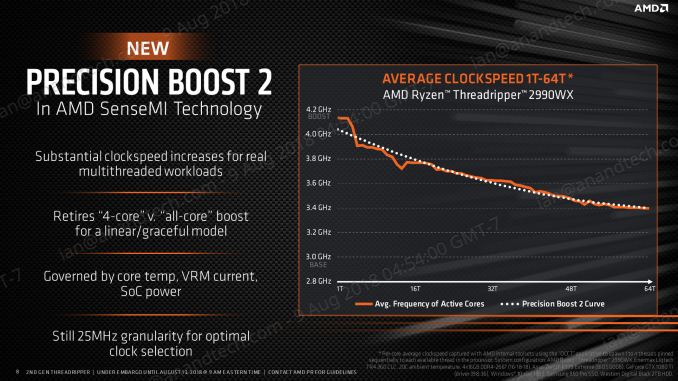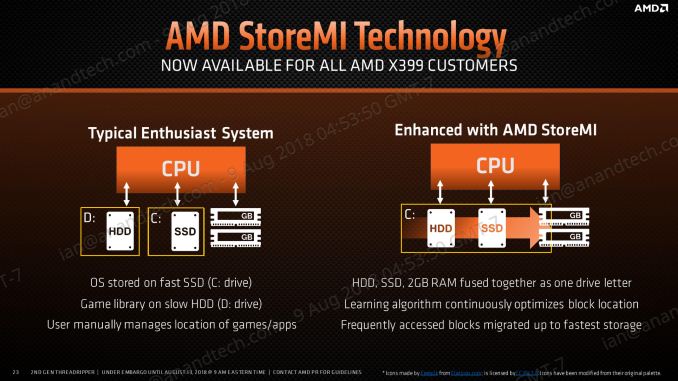The AMD Threadripper 2990WX 32-Core and 2950X 16-Core Review
by Dr. Ian Cutress on August 13, 2018 9:00 AM ESTPrecision Boost 2
Exact per-core turbo timings for the new processors will be determined by AMD’s voltage-frequency scaling functionality through Precision Boost 2. This feature, which we covered extensively in our Ryzen 7 2700X review, relies on available power and current to determine frequency, rather than a discrete look-up-table for voltage and frequency based on loading. Depending on the system default capabilities, the frequency and voltage will dynamically shift in order to use more of the power budget available at any point in the processor loading.
The idea is that the processor can use more of the power budget available to it than a fixed look up table that has to be consistent between all SKUs that are stamped with that number.
Precision Boost 2 also works in conjunction with XFR2 (eXtreme Frequency Range) which reacts to additional thermal headroom. If there is additional thermal budget, driven by a top-line cooler, then the processor is enabled to use more power up to the thermal limit and get additional frequency. AMD claims that a good cooler in a low ambient situation can compute >10% better in selected tests as a result of XFR2.
Ultimately this makes testing Threadripper 2 somewhat difficult. With a turbo table, performance is fixed between the different performance characteristics of each bit of silicon, making power the only differentiator. With PB2 and XF2, no two processors will perform the same. AMD has also hit a bit of a snag with these features, choosing to launch Threadripper 2 during the middle of a heatwave in Europe. Europe is famed for its lack of air conditioning everywhere, and when the ambient temperature is going above 30ºC, this will limit additional performance gains. It means that a review from a Nordic publication might see better results than one from the tropics, quite substantially.
Luckily for us we tested most of our benchmarks while in an air conditioned hotel thanks to Intel’s Data-Centric Innovation Summit which was the week before launch.
Precision Boost Overdrive
The new processors also support a feature called Precision Boost Overdrive, which looks at three key areas for power, thermal design current, and electrical design current. If any of these three areas has additional headroom, then the system will attempt to raise both the frequency and the voltage for increased performance. PBO is a mix of ‘standard’ overclocking, giving an all core boost, but gives a single core frequency uplift along with the support to still keep Precision Boost trying to raise frequency in middle-sized workloads, which is typically lost with a standard overclock. PBO also allows for idle power saving with a standard performance. PBO is enabled through Ryzen Master.
The three key areas are defined by AMD as follows:
- Package (CPU) Power, or PPT: Allowed socket power consumption permitted across the voltage rails supplying the socket
- Thermal Design Current, or TDC: The maximum current that can be delivered by the motherboard voltage regulator after warming to a steady-state temperature
- Electrical Design Current, or EDC: The maximum current that can be delivered by the motherboard voltage regulator in a peak/spike condition
By extending these limits, PBO gives rise for PB2 to have more headroom, letting PB2 push the system harder and further. PBO is quoted by AMD as supplying up to +16% performance beyond the standard.
AMD also clarifies that PBO is pushing the processor beyond the rated specifications and is an overclock: and thus any damage incurred will not be protected by warranty
StoreMI
Also available with the new Ryzen Threadripper 2 processors is StoreMI, AMD’s solution to caching by offering configurable tiered storage for users that want to mix DRAM, SSD, and HDD storage into a single unified platform. The software implementation dynamically adjusts data between up to 2GB of DRAM, up to 256 GB of SSD (NVMe or SATA), and a spinning hard drive to afford the best reading and writing experience when there isn’t enough fast storage.
AMD initially offered this software as a $20 add-on to the Ryzen APU platform, then it became free (up to a 256GB SSD) for the Ryzen 2000-series processors. That offer now extends to Threadripper. AMD’s best case scenario is citing a 90% improvement in loading times.













171 Comments
View All Comments
eva02langley - Tuesday, August 14, 2018 - link
You don't get it, it is a proof of concept and a disruptive tactic to get notice for people to consider AMD in the future... and it works perfectly.KAlmquist - Thursday, August 16, 2018 - link
That's what I meant by “bragging rights.”eva02langley - Thursday, August 16, 2018 - link
You are missing the business standpoint, the stakeholders and the proof of concept.Nvidia is surfing on AI, however the only thing they did so far is selling GPU during a mining craze, however people drink their coolaid and the investors are all over them. The hangover is going to be hard.
Lolimaster - Monday, August 13, 2018 - link
If you're a content creator the Threaripper 2950X is you bitch, period.MrSpadge - Tuesday, August 14, 2018 - link
Ian, does the power consumption of uncore (IF + memory controller) scale with IF + memory controller frequency? I would expect so. And if not: maybe AMD is missing on huge possible power savings at lower frequencies. Not sure if overall efficiency could benefit from that, though, as performance and power would simulataneously regress.dynamis31 - Tuesday, August 14, 2018 - link
It's not all silicon !Windows OS and applications running on that OS may also be software optimised for more 2990WX workloads as you can see below :
https://www.phoronix.com/forums/forum/phoronix/lat...
dmayo - Tuesday, August 14, 2018 - link
Meanwhile, in Linux 2990WX destroyed competition.https://www.phoronix.com/scan.php?page=article&...
https://www.phoronix.com/scan.php?page=article&...
eva02langley - Tuesday, August 14, 2018 - link
I am beginning to ask myself if this is related to Windows. Or maybe the bench suites reliability toward such a unique product.But yeah, these results are insane.
MrSpadge - Tuesday, August 14, 2018 - link
Crazy results, indeed. And quite believable, considering how well the 16 core TR fares in comparison in many windows benches. I suspect the scheduler is not yet tuned for the new architecture with 2 different NUMA levels.And for at least parts of the benchmarks I suspect something a lot less technical is happening: Phoronix can only bench cross-platform software for this comparison. However, hardly any Windows programmer is regularly building Linux versions. That leaves just another option: Linux programs which also got a Windows build. And considering how downright hostile Linux fans can be towards Windows and anything Microsoft-related, I wouldn't be surprised if the tuning going into these compilations was far from ideal. Some of these guys really enjoy shouting out loud that they don't have access to any Windows machine to test their build (which they only did to stop the requests flooding their inbox) and to shove down their users throat that Windows is a second class citizen in their world. This point is reinforced by the wierd names of many of the benchmarks - except 7-zip, is anyone using those programs?
GreenReaper - Wednesday, August 15, 2018 - link
Most aren't dedicated benchmarks, they're useful programs being run as such:* x264 powers most CPU-based H.264/AVC video encoding. Steam uses it, for example.
* GraphicsMagick is a fork of ImageMagick, one of which is used in a large number of websites (probably including this one) for processing images.
* FFmpeg is for audio and video processing.
* Blender is a popular open-source rendering tool.
* Minion is for constraint-solving (e.g. the four-colour map problem).
Many aren't the kind of things you'd run on a regular desktop - but a workstation, sure. They are CPU-intensive parallel tasks which scale - or you hope will scale - with threads.